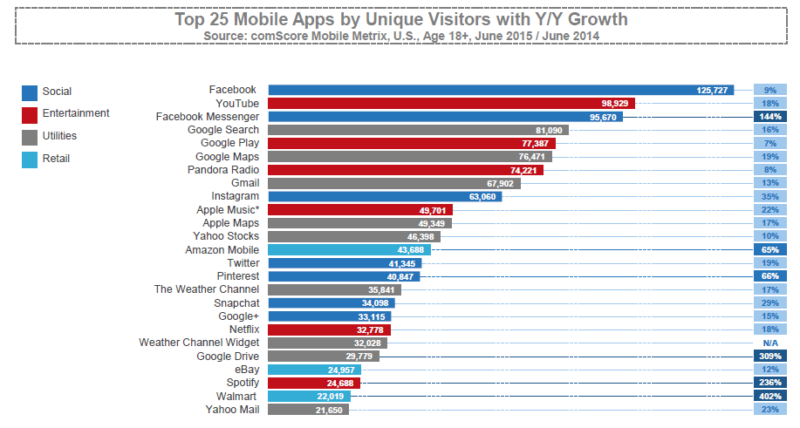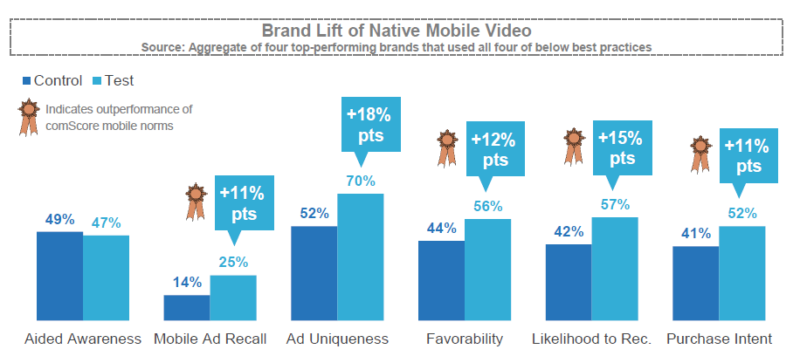Apps consume the majority of mobile media time, but local business apps struggle to compete for attention. Columnist Wesley Young looks at how SMBs can instead use space on the most popular apps to get in front of customers.
Much of the growth in mobile can be attributed to apps. In its 2015 US Mobile App Report, comScore reports that while time spent in mobile digital media use has grown 49 percent since 2013, app usage grew by 90 percent during that same period and constituted 77 percent of all time spent on digital media.
With all that time spent on apps, is there a way that local businesses can get a piece of the action?
The problem is that the average smartphone user only visits about 25 apps each month — and 96 percent of time spent on smartphone apps occurs in the user’s top 10 apps. (Tablet users are even higher, spending 99 percent of their app time on their top 10 apps.) That doesn’t leave much room for a small local business to get attention via its own app.
The one exception might be for businesses built on frequent habitual use, like coffee shops or fitness centers. Popular apps like Facebook get regular return visits through constantly updated news feed content that users get into the habit of checking. Starbucks increased unique users of its app by 100 percent from 2013 to 2015, comScore finds, and Dunkin Donuts, while capturing fewer visitors overall, increased use by 456 percent in the same period. Never underestimate the power of users’ strong daily coffee habits.
Nevertheless, building a solo app likely isn’t a good investment for your average local business. But there are ways that local businesses can get exposure on third-party apps. ComScore ranked the Top 25 apps by unique visitors, as illustrated in the chart below.
Source: The 2015 U.S. Mobile App Report, comScore
While a vast national user base for these third-party apps may not seem relevant to a local business that is only trying to attract a tiny segment of the market, broad use means there is a greater chance that the local business’s audience uses the app and therefore can help provide exposure for the store or business.
Below, I look at seven ways small businesses can take advantage of third-party apps to help drive search results and customers to their stores.
1. Same Bat Time, Same Bat Channel For Google
While Google Search isn’t the #1 app used as measured by unique visitors, it remains the dominant app used to search for information (and is still ranked at #4 overall). Just as importantly for local search, Google Maps ranks at #6, and Google+ is in comScore’s top 20. YouTube, also owned by Google, is the second-most used app and does play a function in search.
There appears to be no difference in search results between mobile search on Google’s mobile site and Google’s search app, although some of the 3-pack local search results that appear at the top do vary. This simply emphasizes the importance of making sure you claim your business on Google My Business and that you keep your business profile up-to-date. That includes business name, location, contact details, description, photos and business hours.
It might seem basic, but maintaining an accurate and up-to-date profile is just too important not to emphasize, and the impact is cross-media and cross-platform on Google, including on search, maps, Google+, desktop, mobile web and mobile apps.
Also, Apple Maps is ranked #11. Don’t forget to claim your business on this platform, which will also impact voice search through Siri.
2. Facebook: The Goliath App
That Facebook is the #1 app by unique visitors is no surprise. But its margin of dominance might be.
Per comScore, the Facebook app is installed on more than 70 percent of all smartphone users’ mobile devices. It hogs time spent on apps, with almost 50 percent of its users spending more time on Facebook than any other app — and it is in the top three apps (in terms of time spent) for 80 percent of its users. In the app equivalent of page one rank, Facebook is on more than 45 percent of users’ home screens, with Google Search (the closest competitor) appearing on less than 30 percent of home screens.
This makes Facebook a great tool for engaging with existing customers who are likely familiar with and active on the app. Small businesses can post photos of new products, communicate special offers or discounts, educate with timely tips or talk about upcoming events, all of which appear as posts on customer news feeds (subject to Facebook’s news feed algorithm).
“Boosted” posts are paid for like ads and appear higher up in user news feeds, increasing the chances that they will be seen.
Using Facebook pages allows local businesses to take advantage of the time users spend on the app while encouraging engagement with the business and keeping the store or service top-of-mind for customers.
3. Messaging: Virtually Exclusive On Apps
Facebook also has a massive presence in another category of app: messaging. Almost all messaging now occurs through an app — comScore reports that 91 percent of instant messaging is driven by apps. Facebook Messenger ranks #3 in unique users, while Snapchat ranks #17.
With the proliferation of texting and the comfort users have with messaging, consumers will start expecting to likewise communicate with businesses this way. Facebook has started facilitating this communication via “click to message” ads on Messenger. A user who clicks on the “message” button on the ad will be prompted to type a question or comment, and the business pays for the ad once it is sent.
Source: Facebook
Facebook will also begin allowing businesses to private message replies to comments posted on the business’s Facebook page. Together, these functions allow businesses to further engage personally with customers and respond quickly to questions, both of which improve customer experience with the business.
Snapchat’s advertising is based in the platform’s curated content via Discover and Live, both of which still focus on the use of video or photo “snaps.” Discover contains content from popular publishers such as Mashable, BuzzFeed, People and ESPN. Live consists of user snaps from a common location or event. Advertisers can target based on content and location but should be aware of the platform’s heavy Millennial user base.
Nevertheless, Snapchat remains an intriguing platform for advertising, given its emphasis on video. ComScore reports double-digit lift in five of six measurements of the effectiveness of native mobile video: mobile ad recall, ad uniqueness, favorability, likelihood to recall and purchase intent.
Source: The 2015 U.S. Mobile App Report, comScore
4. Not Your Father’s Directory
Directory listings may have evolved in the way they are presented, but they are still one of the primary ways that consumers find information on local businesses. Every major directory listing company has an app, and many are using additional functionality to attract users.
From YP’s app, you can directly book a table, order online, buy movie tickets and find cheap gas. Yellowbook highlights weather and emphasizes location through maps and its Google-esque “Nearby” search feature.
Vertical-specific directory listings have also had great success with apps. OpenTable leveraged online reservations to build its directory. GrubHub specializes in ordering takeout or delivery. And Yelp, best known for its directory of food and drink establishments, made online reviews ubiquitous with listings.
Consumer local search behavior shifted to mobile sooner than general internet use, in large part because consumers began to seek information on local businesses while on the go. Certain content categories are now driven primarily by app use for that same reason: on-the-go utilities such as Maps, at 89 percent, and Weather, at 78 percent, get most of their digital time spent from apps.
Directories are likely to follow suit, especially those in local search verticals such as restaurants, as they adapt to on-the-go usage behavior by incorporating directions, click-to-call links and e-commerce functionality. In order to take advantage, local businesses need to make sure their links and listings accommodate functions like on-the-go orders or reservations and that their location on maps is accurate.
5. Food & Retail Are Perfect For Visual Discovery Apps
Social media is the single largest app category in time spent on apps, at 29 percent of all time spent. While social media is very effective for engaging with existing customers, I’ve generally been of the opinion that it is less effective in helping customers search for and discover new local businesses.
The exceptions are restaurants and retailers, who can use visuals to highlight their products. Instagram is in the Top 10 and Pinterest in the Top 15 of comScore’s app rankings by unique visitors, and both use images as their primary mode of sharing. Users love to browse through pictures, and it’s a great opportunity for businesses to be creative and use color, art, photography, video and shot selection to showcase stores and products.

Pinterest recently recognized the value it brings to food and retail businesses by announcing that it was only providing full customer support for businesses in those sectors.
And Instagram lifted its restriction on advertising to select brands a few months ago so that all businesses can take advantage of finely tuned targeting using data from its parent company, Facebook. Advertisers are given more content options than free users, such as longer videos (30 seconds) and permission to link to outside platforms or pages through calls to action.
6. Apps Will Open Doors To Other Marketing Technologies
Beacon technology seems to offer incredible potential for business. It provides real-time notice of who’s walking into a store (or even a specific part of a store) and helps to serve up personalized offers or information at the right time and right place.
However, beacon use for local businesses suffers a derivative problem related to apps. Beacons usually interact with a store’s app to identify patrons, a problem if the store doesn’t have its own app.
Solutions are developing, though. The same third-party apps that local businesses can leverage now will eventually expand their functionality to beacon technology. It’s already happened with Facebook. Last year, the company started giving away beacons that would trigger “Place Tips” when a customer accesses Facebook while in the store, assuming Bluetooth and location sharing are on.
“Place Tips” works like a dedicated page that curates a mix of friends’ posts and pics that mention the business and content from the business’ own page to provide helpful information to the user. It also encourages engagement through likes and shares.
![]()
Source: Facebook
While businesses currently have limited control over pushing specific content to users triggered by the beacon, it’s easy to see how a popular app like Facebook will continue to grow these opportunities and open doors for small businesses to benefit from this and other new technologies.
7. App Content Indexed For Search
Coming full circle back to Google Search, the search engine is now including app-only content in its search results. Google will even stream certain apps (in other words, functions normally performed within an app can now be completed on the web).
This has a number of implications:
- SEO must now account for app content competing with websites and the effect that has on PageRank.
- App developers must optimize app content for search algorithms.
- Small businesses that couldn’t rely on enough volume to justify developing an app may get sufficient search exposure to their apps to change that investment decision.
- App content on pages of popular websites such as Facebook will become even more important.
Conclusion
Mobile web still remains the primary platform local businesses need to adapt to. When comparing the Top 1000 mobile apps to the Top 1000 mobile web properties, the web still has 2.5X the audience of apps, and the latter is growing twice as fast.
Nevertheless, app users are loyal, and their use consumes most of the time spent on mobile devices — a sufficient reason to warrant an app marketing strategy, even for small businesses.
In the current marketplace, most local businesses won’t want to invest in an individual app, but there are still many ways that they can leverage space on the most popularly used apps to gain exposure to both existing and new customers.
And it’s important to keep an eye out on developments in the space, as technology continues to boost the utility of having a presence on third-party apps and may change the ROI calculation for local businesses to develop their own.






